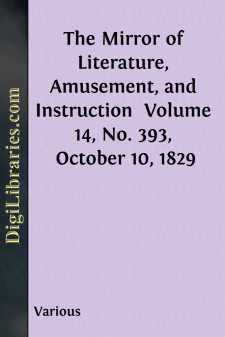Categories
- Antiques & Collectibles 13
- Architecture 36
- Art 48
- Bibles 22
- Biography & Autobiography 813
- Body, Mind & Spirit 142
- Business & Economics 28
- Children's Books 15
- Children's Fiction 12
- Computers 4
- Cooking 94
- Crafts & Hobbies 4
- Drama 346
- Education 46
- Family & Relationships 57
- Fiction 11829
- Games 19
- Gardening 17
- Health & Fitness 34
- History 1377
- House & Home 1
- Humor 147
- Juvenile Fiction 1873
- Juvenile Nonfiction 202
- Language Arts & Disciplines 88
- Law 16
- Literary Collections 686
- Literary Criticism 179
- Mathematics 13
- Medical 41
- Music 40
- Nature 179
- Non-Classifiable 1768
- Performing Arts 7
- Periodicals 1453
- Philosophy 64
- Photography 2
- Poetry 896
- Political Science 203
- Psychology 42
- Reference 154
- Religion 513
- Science 126
- Self-Help 84
- Social Science 81
- Sports & Recreation 34
- Study Aids 3
- Technology & Engineering 59
- Transportation 23
- Travel 463
- True Crime 29
The Mirror of Literature, Amusement, and Instruction Volume 14, No. 393, October 10, 1829
by: Various
Categories:
Description:
Excerpt
Glammis Castle
Here is a castellated palace, or princely castle, associated with many great and daring events in the roll of Scottish history. It stands in the valley of Strathmore, in a park of 160 acres, a little to the north of Glammis, a village of Angus, N.B. The original foundation is of high antiquity; for Malcolm II. was assassinated here in the year 1034, and the chamber in which he expired is still shown. Two obelisks, one near the Manse, and the other in a neighbouring field, denote the places where he was attacked. In this castle also, according to some historians, Macbeth murdered Duncan. We notice, however, that Sir Walter Scott, in his recently-published version of the story of Macbeth, states the murder to have been committed at "a great castle near Inverness," in which he is corroborated by Bæthius, who says, the castle stood upon an eminence south-east of Inverness. But Fordun says the murder was perpetrated near Elgin; and others say at Cawdor Castle.
The Castle originally consisted of two rectangular towers, longer than broad, with walls of fifteen feet in thickness; they were connected by a square projection, and together formed a figure somewhat like the letter Z, saving that in the castle all the angles were right ones; this form gave mutual defence to every part of the building. It contains a spiral staircase of 143 steps, reaching from the bottom to the top of the building.
Glammis Castle is still the seat of the Strathmore family. It was given by Robert I. of Scotland, in the year 1376, with his daughter, to John Lyon, Lord Glammis, chancellor of Scotland. Great alterations and additions were made to the building by Patrick, Earl of Strathmore, his lineal heir and successor: these improvements, according to the above cited plan, a date carved on a stone on the outside of the building, and other authorities, were made in the year 1606, and not in 1686, as is said in an old print engraved about that time, and from which our view is copied. The architect employed on this occasion, as tradition reports, was Inigo Jones; indeed, the work seems greatly to resemble Heriot's Hall at Edinburgh, and other buildings designed by him. The great hall was finished in the year 1621; it is a handsome room with a carved ceiling, adorned with heads and ornaments in stucco. Among the apartments shown to visitors, are a wardrobe containing a curious collection of old state dresses; the armoury, in which are preserved the sword and coat of mail of Macbeth, as well as some articles supposed to have been carried off by Malcolm's murderers, and found in the Loch of Forfar, during the last century; and the chapel built about 1500, the furniture of which remains in its original state. Here also are about one hundred portraits; among which is a large picture, in a carved frame, representing Earl Patrick and his three sons; in the background is a view of the castle, as it was in the year 1683. At that time there were three gates leading from the park. Some idea may be formed of the extent of this establishment from the circumstance of eighty beds being made up within the house, for the Pretender and his retinue, during their sojourn here, besides those for the inferior servants, in the offices out of doors....












